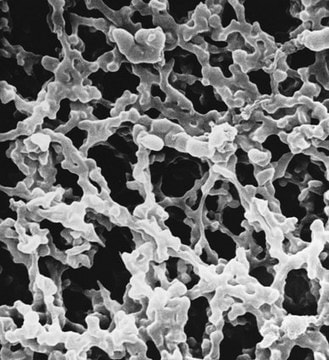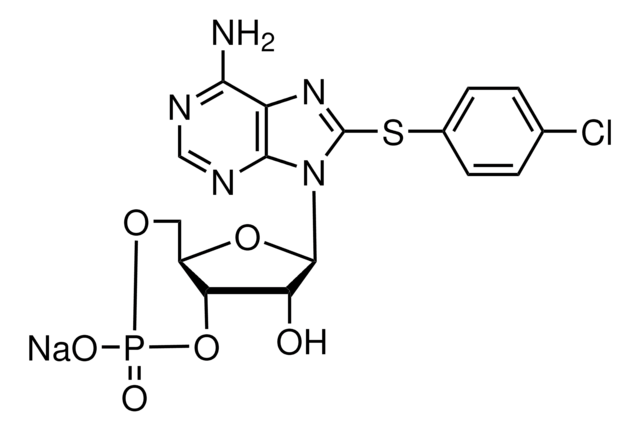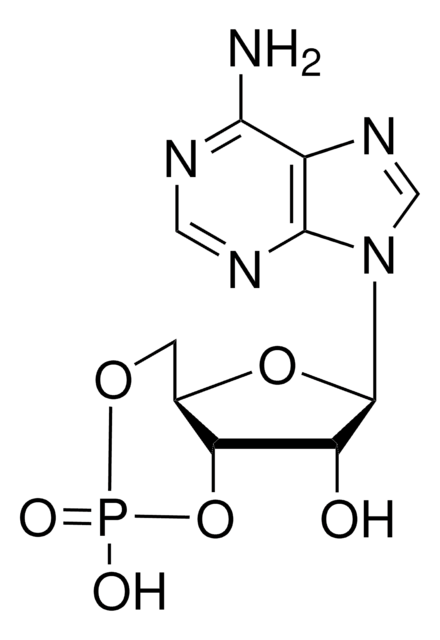B8279
Ro-20-1724
≥98% (HPLC), solid, cAMP phosphodiesterase inhibitor
Sinonimo/i:
Ro 20-1724
About This Item
Prodotti consigliati
product name
4-(3-Butoxy-4-methoxybenzyl)imidazolidin-2-one, solid
Origine biologica
synthetic (organic)
Saggio
≥98% (HPLC)
Forma fisica
solid
Solubilità
ethanol: 7 mg/mL
H2O: insoluble
Temperatura di conservazione
room temp
Stringa SMILE
CCCCOc1cc(CC2CNC(=O)N2)ccc1OC
InChI
1S/C15H22N2O3/c1-3-4-7-20-14-9-11(5-6-13(14)19-2)8-12-10-16-15(18)17-12/h5-6,9,12H,3-4,7-8,10H2,1-2H3,(H2,16,17,18)
PDMUULPVBYQBBK-UHFFFAOYSA-N
Informazioni sul gene
human ... LITAF(9516) , PDE4B(5142) , PRKAR1A(5573) , PRKAR1AP(5574) , PRKAR1B(5575) , PRKAR2A(5576) , PRKAR2B(5577)
rat ... Pde4a(25638)
Applicazioni
- as a cyclic adenosine monophosphate (cAMP) phosphodiesterase inhibitor to treat cells for the determination of intracellular cAMP levels
- as a component of serum-free medium
- as phosphodiesterase inhibitor in order to study the effects of protease-activated receptor-1 (PAR-1) activation on cAMP levels
Azioni biochim/fisiol
Caratteristiche e vantaggi
Codice della classe di stoccaggio
11 - Combustible Solids
Classe di pericolosità dell'acqua (WGK)
WGK 3
Punto d’infiammabilità (°F)
Not applicable
Punto d’infiammabilità (°C)
Not applicable
Dispositivi di protezione individuale
dust mask type N95 (US), Eyeshields, Gloves
Certificati d'analisi (COA)
Cerca il Certificati d'analisi (COA) digitando il numero di lotto/batch corrispondente. I numeri di lotto o di batch sono stampati sull'etichetta dei prodotti dopo la parola ‘Lotto’ o ‘Batch’.
Possiedi già questo prodotto?
I documenti relativi ai prodotti acquistati recentemente sono disponibili nell’Archivio dei documenti.
I clienti hanno visto anche
Contenuto correlato
Cyclic nucleotides, including cyclic AMP (cAMP), cyclic GMP (cGMP) and cyclic ADP-ribose, have been extensively studied as second messengers of intracellular events initiated by activation of GPCRs. cAMP modifies cell function in all eukaryotic cells, principally through the activation of cAMP-dependent protein kinase (PKA), but also through cAMP-gated ion channels and guanine nucleotide exchange factors directly activated by cAMP.
Il team dei nostri ricercatori vanta grande esperienza in tutte le aree della ricerca quali Life Science, scienza dei materiali, sintesi chimica, cromatografia, discipline analitiche, ecc..
Contatta l'Assistenza Tecnica.














